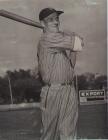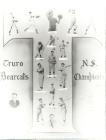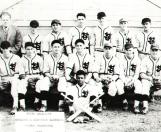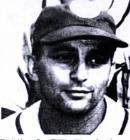1
Rough Diamonds - by Dr. Colin HowellIt was the classic baseball moment. Two out, bottom of the ninth, the home team three runs down and bases loaded in the final game of the best-of-nine 1955 Halifax and District League semi-final. On the mound for the visiting Truro Bearcats was a phenomenal young right-hander, Myron "Moe" Drabowsky out of Trinity College, who the following season would jump directly from Truro to the major leagues without even a whistle stop along the way. Toeing the rubber, and readying his 6'3' 190 pound frame for the final out of the game and series, the young twenty-year old gazed warily at Halifax Cardinals veteran playing coach Art Hoch as he dug in at the plate. A North Carolinian and former All-American shortstop out of Wake Forest College, Hoch was in his fifth season in the league, and had a reputation as a clutch performer. The thing about Drabowsky, many players knew, was that he was always around the plate and usually threw first pitch strikes. Hoch guessed fastball and he was right, the ball rocketing off his bat and over the bleachers in left-center field. "I'll never forget the moment," Drabowsky recently recalled. "The next year I took Art into the Chicago Cubs locker room and introduced him to my team-mates as the last guy to hit a home run off me in semi-pro ball."
4
Everyone who saw Buddy Condy play, fans, teammates, pro-scouts and coaches marveled at his ability to swing the bat. Few doubted that he had the ability to play major league baseball. Winner of the league batting championship in 1949 and 1950, Condy had earlier attracted the attention of professional scouts, and was offered a contract in 1946 to play for the Montreal Royals of the International League. Had he agreed to join the Royals he would have been a teammate of Jackie Robinson, whose signing had led to the breaking of the color bar in Organized Baseball. Condy was not interested in a professional baseball career, however, and had his heart set instead on becoming a medical doctor. Another local, Johnny Clark, whose speed on the basepaths led to the moniker "the Westville Flash", recalls rooming with Condy one season. "It was like Dr. Bobby Brown and Yogi Berra," he laughs, "Buddy with his medical books, and me with my comics."5
Cartoon in a Halifax newspaper by Robert Chambers depicting Johnny Clarke's base stealing prowess.1950

6
Condy had come out of retirement to play for the Cardinals in that summer of 1955, joining the club in mid-season after a two-year hiatus from the league during which he devoted himself to his medical career. Ironically, the pitcher that he faced on his return to the lineup was Drabowsky. Hoch suggested that Buddy delay his return for day, rather than face one of the league's top pitchers who was in mid-season form. Condy ignored the advice. In three appearances at the plate he walked, singled and drove a fly ball to the warning track in center field. After the game, Drabowsky sought Condy out to tell him "you're everything everybody's been telling me about. You hit my very best stuff."Few who knew Condy would have been surprised. Take infielder Jack Stallings who played against Condy before eventually joining the Boston Red Sox organization. Although his major league aspirations would be derailed after contracting polio in the summer of 1955, Stallings subsequently became one of winningest baseball coaches in NCAA history during a thirty year stint as Georgia Southern University. While driving to the airport after a baseball clinic in Halifax a couple years ago, Stallings described Condy to me as the "best hitter I saw anywhere!" He was not just talking about the future major leaguers that he coached over the years. "I went to spring training with the Bosox in 1954 and had the chance to watch Ted Williams first-hand," Stallings observed. "Condy is still the best pure hitter I've ever seen."
9
If Condy symbolized the kind of talent that existed throughout the region at the grass-roots level, he also reflected the marginalization of local players within the H&D league that took place over the years. When the league opened in 1946, most club rosters contained a core of local players who had gained experience playing for service teams and community clubs during the second world war. The star of the league was home-brew Phillip "Skit" Ferguson, a pitcher and first-baseman from Reserve Mines, who won 17 games and batted .438 for the league champion Truro Bearcats. The Bearcat lineup also featured Maritimers Billy McIntyre, Hum Joseph and Johnny Clark. The league's local talent was supplemented by a number of imports from the United States and from other parts of Canada, some of whom had been in Halifax during the war. Leading the roll-call of imports were "Peaches" Ruven, batting champion of the Halifax Defence League in 1945, Marcel St. Pierre, a veteran of four seasons in the HDL¸ Winnipeg natives Lou Bourbannais and Mike Genthon, and NHL star George Gee11
Situated on Canada's east coast, Halifax was the major debarkation point for Canadians on their way overseas, and servicemen from across the country were often stationed here during the war. Among them were some of the best athletes that the country had to offer, including National Hockey League stars Bob Goldham, Joe Klukay, Milt Schmidt, Gaye Stewart, and Bob Dill, and major league ballplayers Dick Fowler and Phil Marchildon of the Philadelphia Athletics and Joe Krakauskas of the Cleveland Indians. In his memoirs Marchildon remembers the rough reception he received in his initial outing in Halifax from a Halifax Navy club who collected eleven hits and scored seven runs against him. He was particularly impressed by Danny Seaman who went three for four against him that day, and five for thirteen with a double and home-run over the season. "Seaman," Marchildon mused, "hits the ball too hard and too often to be playing in Nova Scotia." Danny Seaman would go on to star in the H&D League for a number of years, along with brothers Garneau, Kal and Ike. According to Paul Thompson, onetime General Manager of the Chicago Black Hawks, teams in the Halifax Defense League played the fastest baseball in the country at the time except for the two Canadian franchises in the International League.13
Halifax and District Baeball League action between the Halifax Arrows and the Halifax Shipyards1946
Wanderers Grounds, Halifax, Nova Scotia

14
After the war The H&D League replaced the old Halifax Defense League, and operated for 15 seasons between 1946 and 1959. For the first few years, roughly from 1946-1950 the league maintained a relatively healthy balance between imported and local players; a second era spanned the years 1951 to 1955 when most clubs pushed locals aside and concentrated on a blend of veteran players and college prospects from the United States; and then the final stage from 1956 to 1959 in which clubs relied almost exclusively on young prospects tabbed as potential future stars by major-league organizations. Alongside the H&D League, moreover, there was the Central League, which operated for four years before folding after the 1949 season.Over the years the average age of players fell, the quality of play diminished as players with less experience were signed, and fan support eroded. Attendance figures for the Stellarton Albions, one of the stalwart franchises in the league in the early years, tells the tale. During the 1951 season, when the H&D League was at the height of its popularity, the league champion Albions drew over 46,000 fans to the ballpark; seven years later they wouldn't draw a quarter of that number. In part, the league's declining fortunes can be attributed to the same forces that had led to the contraction of minor league and small-town baseball across North America, among them the coming of television and the expanded mobility and vacation options that accompanied growing numbers of families who owned an automobile. At the same time, as the league became a summer league for American college prospects, similar in its makeup to the Cape Cod League today, it lost many of the ingredients that it had made it successful earlier. By 1957 the league had shrunk from six teams to four, and further defections made it impossible to operate after the completion of the 1959 season.





